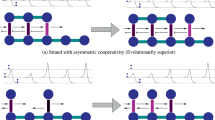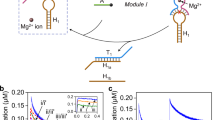Abstract
MOLECULAR replication, a fundamental process of life, has in recent years been the subject of laboratory investigations using simple chemical systems1–10. Whereas the work of Rebek's group4,5 has focused on molecular architectures not known in living systems, self-replicating and template-based self-assembling systems based on nucleotides6–8 are regarded as potential models for exploring the evolution of replicating systems on the early Earth. Previous replicating oligonucleotides have been of the single-stranded, self-complementary type: small oligonucleotide fragments are assembled on a pre-existing template and linked to form an exact copy of the template. This process cannot easily be reiterated, however, because of the strong binding of the newly formed strand to the original template. Furthermore, DNA replication in living systems operates by complementarity rather than self-complementarity—each newly assembled strand is complementary to, rather than identical to, its template—and the replication process starts and finishes with double helices. Here we report the self-replication of palindromic (symmetrical) duplex DNA-like oligonucleotides, 24 monomers long, in the absence of enzymes by means of a cycle that transfers information from template to copy and is potentially capable of extension to include non-symmetrical sequences, selection and mutation. Replication proceeds by a chemical process involving the formation of an intermediate triplex structure, and is sequence-selective in the sense that mismatches impair its efficiency. These results indicate that DNA-like double-helical molecules can replicate without assistance from proteins, a finding that may be relevant both to the appearance of replicating systems on the early Earth and to the development of new approaches to DNA amplification.
This is a preview of subscription content, access via your institution
Access options
Subscribe to this journal
Receive 51 print issues and online access
$199.00 per year
only $3.90 per issue
Buy this article
- Purchase on Springer Link
- Instant access to full article PDF
Prices may be subject to local taxes which are calculated during checkout
Similar content being viewed by others
References
Orgel, L. E. Nature 358, 203–209 (1992).
Joyce, G. F. Nature 338, 217–224 (1989).
Hoffmann, S. Angew. Chem. int. Edn engl. 31, 1013–1016 (1992).
Tjivikua, T., Ballesten, P. & Rebek, J. Jr J. Am. chem. Soc. 112, 1249–1250 (1990).
Feng, Q., Park, T. K. & Rebek, J. Jr Science 256, 1179–1180 (1992).
von Kiedrowski, G. Angew. Chem. int. Edn. engl. 25, 932–935 (1986).
von Kiedrowski, G., Wlotzka, B. & Helbing, J. Angew. Chem. int. Edn engl. 28, 1235–1237 (1989).
von Kiedrowski, G., Wlotzka, B., Helbing, J., Matzen, M. & Jordan, S. Angew. Chem. int. Edn. engl. 30, 423–426 (1991).
Goodwin, J. T. & Lynn, D. G. J. Am. chem. Soc. 114, 9197–9198 (1992).
Kanavarioti, A. J. theor. Biol. 158, 207–219 (1992).
Eschenmoser, A. & Lowewenthal, E. Chem. Soc. Rev. 21, 1–16 (1992).
Maher, L. J., Dervan, P. B. & Wold, B. J. Biochemistry 29, 8820–8826 (1990).
Leubke, K. J. & Dervan, P. B. J. Am. chem. Soc. 111, 8733–8735 (1989).
Inoue, T. & Orgel, L. E. Science 219, 859–862 (1983).
Acevedo, O. L. & Orgel, L. E. J. molec. Biol. 197, 187–193 (1987).
Chen, C. B., Inoue, T. & Orgel, L. E. J. molec. Biol. 181, 271–279 (1985).
Kanavarioti, A., Bernasconi, C. F., Alberas, D. J. & Baird, E. E. J. Am. chem. Soc. 115, 8537–8546 (1993).
Kanaya, E. & Yanagawa, H. Biochemistry 7423–7430 (1986).
Miller, S. L. in Cold Spring Harbor Symp. quant. Biol. LB, 17–27 (1987).
Gedulin, B. & Arrhenius, G. in Early Life on Earth (ed. Bengston, S.) 91–110 (Nobel. Symp. No. 84, Columbia Univ. Press, New York, 1993).
Ferris, J. P. & Ertem, G. J. Am. chem. Soc. 115, 12270–12275 (1993).
Hunziker, J. et al. Helv. chim. Acta 76, 259–352 (1993).
Eschenmoser, A. Chem. Biol. Introd. issue iv–v (1994).
Author information
Authors and Affiliations
Rights and permissions
About this article
Cite this article
Li, T., Nicolaou, K. Chemical self-replication of palindromic duplex DNA. Nature 369, 218–221 (1994). https://doi.org/10.1038/369218a0
Received:
Accepted:
Issue Date:
DOI: https://doi.org/10.1038/369218a0
This article is cited by
-
Nonenzymatic polymerase-like template-directed synthesis of acyclic l-threoninol nucleic acid
Nature Communications (2021)
-
From quasispecies to quasispaces: coding and cooperation in chemical and electronic systems
European Biophysics Journal (2018)
-
A viscous solvent enables information transfer from gene-length nucleic acids in a model prebiotic replication cycle
Nature Chemistry (2017)
-
Exponential growth and selection in self-replicating materials from DNA origami rafts
Nature Materials (2017)
-
Template-directed Chemical Ligation to Obtain 3′-3′ and 5′-5′ Phosphodiester DNA Linkages
Scientific Reports (2014)
Comments
By submitting a comment you agree to abide by our Terms and Community Guidelines. If you find something abusive or that does not comply with our terms or guidelines please flag it as inappropriate.



